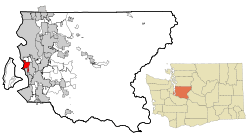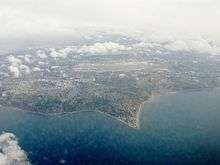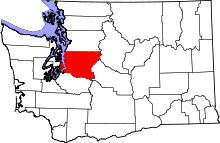Burien, Washington
| Burien, Washington | ||
|---|---|---|
| City | ||
| ||
 Location of Burien, Washington | ||
| Coordinates: 47°28′6″N 122°20′44″W / 47.46833°N 122.34556°WCoordinates: 47°28′6″N 122°20′44″W / 47.46833°N 122.34556°W | ||
| Country | United States | |
| State | Washington | |
| County | King | |
| Government | ||
| • Type | Council-Manager | |
| • Mayor | Lucy Krakowiak | |
| • City Council |
Seven at large members (four year terms): Steve Armstrong, Lauren Berkowitz, Bob Edgar, Jerry Robison, Nancy Tosta, Debi Wagner | |
| • City Manager | Kamuron Gurol . | |
| Area[1] | ||
| • Total | 13.23 sq mi (34.27 km2) | |
| • Land | 7.42 sq mi (19.22 km2) | |
| • Water | 5.81 sq mi (15.05 km2) | |
| Elevation | 377 ft (115 m) | |
| Population (2010)[2] | ||
| • Total | 33,313 | |
| • Estimate (2015)[3] | 50,467 | |
| • Rank | US: 748th | |
| • Density | 4,489.6/sq mi (1,733.4/km2) | |
| Time zone | Pacific (PST) (UTC-8) | |
| • Summer (DST) | PDT (UTC-7) | |
| ZIP codes | 98146, 98148, 98166, 98168 | |
| Area code(s) | 206 | |
| FIPS code | 53-08850 | |
| GNIS feature ID | 1534570[4] | |
| Website | www.burienwa.gov | |
Burien (/ˈbjʊəriən/ BYUR-ee-ən) is a suburban city in King County, Washington, United States, located south of Seattle. As of the 2010 Census,[5] Burien's population was 33,313, which is a 49.7% increase since incorporation. An annexation in 2010 increased the city's population to about 50,000.[6]
History
Settlement in the Burien area dates to 1864, when George Ouellet (1831–1899), a French-Canadian born in Sainte-Marie-de-Beauce, Quebec, purchased his first of several land patents for homestead sites directly from a Federal land office.[7] Ouellet had first arrived in the Washington Territory at Port Madison on Bainbridge Island, off of the Kitsap Peninsula, in 1858. Three years after purchasing his homestead in the Burien area, he married 14-year-old Elizabeth Cushner, who was born in the Washington Territory, and started a family. Several years later, the Ouellet family moved to the White River Valley, near Auburn.
A popular local tale recounts that an early settler named Mike Kelly gave the community its first name after he emerged from the trees and said, "This is truly a sunny dale." Today, a few long-time residents still refer to the Burien area as Sunnydale.
In 1884, Gottlieb Burian (1837–1902) and his wife Emma (Wurm) Burian (1840–1905), German immigrants from Hussinetz, Lower Silesia, who owned two taverns in downtown Seattle, arrived in Sunnydale.[7] The tiny community was without improved roads or commercial buildings, reached primarily by trails.[7] Burian built a cabin on the southeast corner of Lake Burien and reportedly formed the community into a town bearing his name (misspelled over the years).[7] A real estate office was built and soon attracted large numbers of new residents to Burien.[7]
In the early 1900s, visitors from Seattle came by the Mosquito Fleet to Three Tree Point, just west of town to sunbathe and swim.
In 1915, the Lake Burien Railway was completed. It ran on what is today Ambaum Boulevard from Burien to White Center to Seattle. A small passenger train ran the tracks and was affectionately named by the residents, The Toonerville Trolley. However, in the summer, squished caterpillars made the track slippery, and in the winter, the tracks iced over. Soon the Toonerville Trolley was removed.
Incorporation
Several proposals to incorporate the greater Burien area, an unincorporated portion of King County, were attempted but failed. In the late 1980s and early 1990s, citizens felt they needed a more responsive government to help address the looming threat of the Port of Seattle's airport runway expansion (known as the "Third Runway") to the west, so an effort was again made to incorporate as a city. Citizens also felt that multi-family apartments and dwellings had proliferated out of control in Burien and other unincorporated areas of King County, and that they had no local voice in government, other than the King County Council, that would hear their concerns.
The City of Burien was finally incorporated on February 28, 1993 after voter approval.
Annexation
Late in 2004, the City assessed the possibility of annexing North Highline (which includes White Center and Boulevard Park), "one of the largest urban unincorporated areas of King County," which would double the size of Burien. Many citizens spoke against the annexation and created picket signs and petitions to protest against it. Other citizens welcomed the expansion, as they felt parts of the so-called "North Highline" area should have been part of the original Burien incorporation, and the area in question is part of the larger Highline area. (The Highline area includes the cities of Burien, Seatac, Des Moines, Federal Way and an unincorporated area called "North Highline.")
In May 2008, the Burien City Council proposed an annexation of the southern portion of North Highline, comprising 14,000 residents. In late summer of 2008, the City of Burien prepared to submit their annexation proposal to King County's Boundary Review Board. However, after the City of Seattle protested Burien's proposal, Burien opted to withdraw their annexation plan and resubmit it after new countywide planning policies went into effect.
In October 2008, the Burien City Council voted to resubmit their annexation plan to the county Boundary Review Board. However, the cities of Burien and Seattle, along with King County and other stakeholders, first participated and completed mediation to ensure the interests of all parties involved were met. Affected stakeholders would have agreed to a preliminary annexation framework that stipulated how annexation would play-out between the cities of Burien and Seattle and with King County. However, the Seattle City Council voted against the agreement that February. It is not known if Seattle has any future plans for annexation of any part of the North Highline area.
On April 16, 2009, the Boundary Review Board of King County approved Burien's proposal for annexation of the southern portion of the North Highline area.
In early May 2009, both King County and the City of Burien passed resolutions to place an annexation vote on the August 18th primary ballot. The annexation area voted on consisted of southern North Highline and had an area of about 1,600 acres (6.5 km2) and approximately 14,000 citizens. The ballot issue was approved by a majority of southern North Highline residents, and on April 1, 2010, southern North Highline became part of Burien.[8]
After the annexation vote, a special census was conducted, and it was determined that the newly annexed area had 14,292 residents. This resulted in a new population total of 49,858, making Burien the 23rd largest city in Washington State.
The Boundary Review Board approved a second proposal for Burien to annex northern North Highline (also known as Area Y) in February 2012,[8] but this was rejected by Area Y residents in November 2012.[9]
Current Burien

Burien's downtown area underwent several renovations completed in 2009. The new town center includes 70,000 square feet (7,000 m2) of retail space, more than 400 condominiums with a plaza/park area, plus underground parking.
The city is served by the Highline Times (established 1945), a community weekly newspaper owned by Robinson Newspapers. It is a subscriber-based publication with limited free distribution.
Olde Burien
Olde Burien is a reference for the area surrounding SW 152nd Street. There are shops and restaurants located in this area, such as The Tin Room, The Mark, and Todd's Shoe Repair. The Burien City Hall is located in Olde Burien as well.
Police
Burien contracts with the King County Sheriff's Office for police services. Deputies assigned to Burien wear city uniforms and drive patrol cars marked with the city logo. According to the Chief of Police, there are currently 27 patrol officers, detectives, support personnel and a chief assigned full-time to the city.
Government and infrastructure
The United States Postal Service operates the Burien Post Office and the Seahurst Post Office.[10][11]
Education

Schools in Burien
Burien is served by the Highline School District. High schools in Burien include Highline High School, Big Picture, CHOICE Academy, and the Puget Sound Skills Center,[12] as well as Catholic schools like John F. Kennedy Catholic High School.
Public libraries
King County Library System operates the Burien Library.[13] The current 32,000-square-foot (3,000 m2) facility opened on June 13, 2009.[14] The Boulevard Park Library is a smaller, community library (6,356 sq ft) in the Burien city limits. The 1971 facility is also operated by KCLS, with a history going back to 1937.[15]
Transportation

King County Metro operates public transportation services. The Burien Transit Center began construction in July 2008 and finished in June 2009.[16]
Geography
Burien is located at 47°28′6″N 122°20′44″W / 47.46833°N 122.34556°W (47.468221, -122.345491).[17]
According to the United States Census Bureau, the city has a total area of 13.23 square miles (34.27 km2), of which 7.42 square miles (19.22 km2) is land and 5.81 square miles (15.05 km2) is water.[1]
Demographics

| Historical population | |||
|---|---|---|---|
| Census | Pop. | %± | |
| 1980 | 23,189 | — | |
| 1990 | 25,089 | 8.2% | |
| 2000 | 31,881 | 27.1% | |
| 2010 | 33,313 | 4.5% | |
| Est. 2015 | 50,467 | [18] | 51.5% |
2015 estimate[3] | |||
In the 2004 US presidential election, Burien cast 63.07% of its vote for Democrat John Kerry.
2010 census
As of the census[2] of 2010, there were 33,313 people, 13,253 households, and 8,013 families residing in the city. The population density was 4,489.6 inhabitants per square mile (1,733.4/km2). There were 14,322 housing units at an average density of 1,930.2 per square mile (745.3/km2). The racial makeup of the city was 63.5% White (57.0% Non-Hispanic White), 5.9% African American, 1.5% Native American, 9.9% Asian, 1.8% Pacific Islander, 11.5% from other races, and 5.9% from two or more races. Hispanic or Latino of any race were 20.7% of the population.
There were 13,253 households of which 30.0% had children under the age of 18 living with them, 42.5% were married couples living together, 11.7% had a female householder with no husband present, 6.3% had a male householder with no wife present, and 39.5% were non-families. 31.0% of all households were made up of individuals and 9.7% had someone living alone who was 65 years of age or older. The average household size was 2.49 and the average family size was 3.12.
The median age in the city was 38.5 years. 22.4% of residents were under the age of 18; 8.4% were between the ages of 18 and 24; 28.1% were from 25 to 44; 28.3% were from 45 to 64; and 12.8% were 65 years of age or older. The gender makeup of the city was 50.3% male and 49.7% female.
2000 census
As of the census of 2000, there were 31,881 people, 13,399 households, and 8,066 families residing in the city. The population density was 4,287.0 people per square mile (1,654.5/km²). There were 13,898 housing units at an average density of 1,868.9 per square mile (721.2/km²). The racial makeup of the city was 75.74% White, 5.14% African American, 1.29% Native American, 7.00% Asian, 1.16% Pacific Islander, 5.40% from other races, and 4.28% from two or more races. Hispanic or Latino of any race were 10.66% of the population.
There were 13,399 households out of which 27.1% had children under the age of 18 living with them, 43.5% were married couples living together, 11.6% had a female householder with no husband present, and 39.8% were non-families. 32.4% of all households were made up of individuals and 10.5% had someone living alone who was 65 years of age or older. The average household size was 2.36 and the average family size was 2.98.
In the city the population was spread out with 22.8% under the age of 18, 8.0% from 18 to 24, 30.8% from 25 to 44, 24.7% from 45 to 64, and 13.8% who were 65 years of age or older. The median age was 38 years. For every 100 females there were 96.5 males. For every 100 females age 18 and over, there were 94.7 males.
The median income for a household in the city was $41,577, and the median income for a family was $53,814. Males had a median income of $39,248 versus $29,694 for females. The per capita income for the city was $23,737. About 6.9% of families and 9.4% of the population were below the poverty line, including 13.1% of those under age 18 and 6.1% of those age 65 or over.
References
- 1 2 "US Gazetteer files 2010". United States Census Bureau. Archived from the original on 2012-01-24. Retrieved 2012-12-19.
- 1 2 "American FactFinder". United States Census Bureau. Retrieved 2012-12-19.
- 1 2 "Population Estimates". United States Census Bureau. Retrieved June 15, 2016.
- ↑ "Burien". Geographic Names Information System. United States Geological Survey.
- ↑ "2010 Census Redistricting Data (Public Law 94-171) Summary File". American FactFinder. United States Census Bureau. Archived from the original on 21 July 2011. Retrieved 17 November 2012.
- ↑ "Demographics". City of Burien, WA.
- 1 2 3 4 5 Highline Historical Society, Gottlieb Burian and his Family History: From Hussinetz, Silesia to Sunnydale, Washington, downloaded 29 July 2012
- 1 2 "North Highline Annexation". City of Burien. Archived from the original on October 29, 2012.
- ↑ Swenson, Ty (November 13, 2012). "UPDATE: North Highline voters clearly decline Burien's annexation offer". West Seattle Herald.
- ↑ "Post Office Location – BURIEN." United States Postal Service. Retrieved on August 4, 2009.
- ↑ "Post Office Location – SEAHURST." United States Postal Service. Retrieved on August 4, 2009.
- ↑ "PSSC". Highline School District. Highline Public Schools. Retrieved 28 August 2014.
- ↑ "Burien Library." King County Library System. Retrieved on August 4, 2009.
- ↑ "New Burien Library Opens!." King County Library System. Retrieved on August 4, 2009.
- ↑ "KCLS - Boulevard Park" King County Library System. Retrieved on September 15, 2015.
- ↑ "Burien Washington Archived June 24, 2009, at the Wayback Machine.." King County, Washington. Retrieved on August 4, 2009.
- ↑ "US Gazetteer files: 2010, 2000, and 1990". United States Census Bureau. 2011-02-12. Retrieved 2011-04-23.
- ↑ "Annual Estimates of the Resident Population for Incorporated Places: April 1, 2010 to July 1, 2015". Retrieved July 2, 2016.
- ↑ "Census of Population and Housing (1790–2010)". U.S. Census Bureau. Archived from the original on 2015-05-11. Retrieved 2014-05-29.
- ↑ Census figures for 1980 & 1990 enumerated prior to incorporation as Burien CDP.

